| Columns Retired Columns & Blogs |
....for Jamicon Electrolytic Polarized input capacitors! For $10K! Really?
I examined the Musical Fidelity's measured behavior primarily using Stereophile's loaner sample of the top-of-the-line Audio Precision SYS2722 system (see the January 2008 "As We See It" and www.ap.com); for some tests, I also used my vintage Audio Precision System One Dual Domain.
My first test of an amplifier is to run it for 60 minutes at one-third its specified power into 8 ohms, which is thermally the worst case for an amplifier with a class-B or -AB output stage. The 750K got very hot very quickly, its cooling fans turning on after two minutes, its side-mounted heatsinks reaching 60°C (140°F) after five minutes, and the fans switching to their maximum speed at eight minutes. I ended the test after 10 minutes, before the 750K's thermal sensor cut in, because the Supercharger doesn't have enough heatsink area for sustained operation at high powers. But of course, it can be argued that that is beside the point, as its large output-voltage swing capability is intended to handle musical peaks without waveform clipping. During my auditioning, though the heatsinks did get quite warm, the cooling fans rarely turned on.
The voltage gain into 8 ohms was a fairly high 29.9dB for the balanced line-level input, 29.2dB for the unbalanced input. The speaker-level inputs offered just 7.1dB of voltage gain, close to the specified 6.9dB. All three inputs preserved absolute polarity; ie, were non-inverting. The speaker inputs offered an input impedance almost identical to the specified 50 ohms, at 49.5 ohms, while the line-level input impedances were 47.5k ohms (unbalanced input and each leg of the balanced input) at low and midrange frequencies, dropping slightly and inconsequentially to 40k ohms at 20kHz.
The output impedance was a little higher than usual for a solid-state design, at 0.11 ohm at 20Hz and 1kHz, rising to 0.22 ohm at 20kHz, which resulted in frequency-response variations of ±0.1dB with our standard simulated loudspeaker (fig.1, red trace). The small-signal bandwidth was a wide 150kHz into 8 ohms (fig.1, blue trace), but dropped with decreasing load impedance, reaching –3dB at 56kHz and –1.35dB at 20kHz into 2 ohms (fig.1, magenta trace). This graph was taken using the balanced input; the unbalanced input produced an identical result. The wide bandwidth results in excellent squarewave response (figs. 2 and 3), though the faintest hint of overshoot is visible.
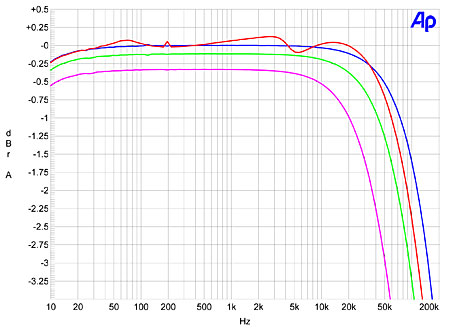
Fig.1 Musical Fidelity 750K Supercharger, frequency response at 2.83V into simulated loudspeaker load (red), 8 ohms (blue), 4 ohms (green), 2 ohms (magenta). (0.25dB/vertical div.)
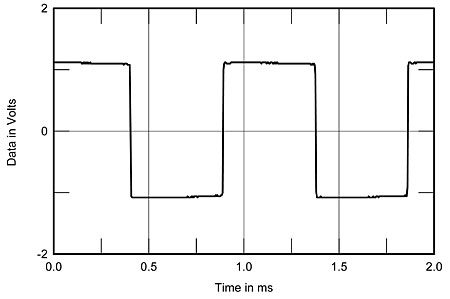
Fig.2 Musical Fidelity 750K Supercharger, small-signal 1kHz squarewave into 8 ohms.
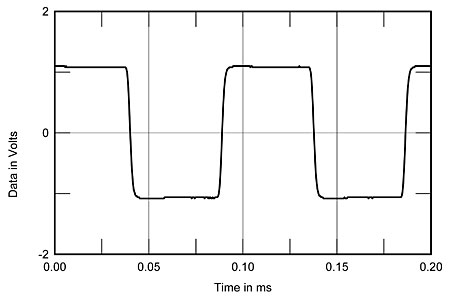
Fig.3 Musical Fidelity 750K Supercharger, small-signal 10kHz squarewave into 8 ohms.
The 750K's signal/noise ratio (unweighted, wideband, ref.1W into 8 ohms) was a good 79.5dB, this increasing to 90dB when A-weighted. Considering the amplifier's high gain of 30dB, this gives it a very high dynamic-range capability of almost 120dB, which, in terms of a digital system, is almost equivalent to 20 bits. This is an amplifier that can handle the full dynamic range of high-resolution recordings. Fig.4 plots the percentage of THD+noise in the Musical Fidelity's output against continuous output power into 8, 4, and 2 ohms. The downward slope of the traces below 200W or so in this graph implies that the actual distortion is below the level of the background noise—this is an extremely linear amplifier, at least into 8 and 4 ohms. The 750K obviously has more difficulty driving 2 ohms, as witnessed by the small discontinuities in the trace above a few tens of watts. Clipping power (defined as 1% THD+N) was enormous, at 760W into 8 ohms (28.8dBW), 1050W into 4 ohms (27.2dBW), and 1200W into 2 ohms. That the Musical Fidelity doesn't quite meet its 1150W specification into 4 ohms can be explained by the fact that while I have a dedicated 20A AC line feeding power to my test bench, I don't hold the AC voltage constant. So while the AC supply was 124.9V with the 750K idling, it dropped to 121.5V with the amplifier clipping into 8 ohms, and to 119.8V with it clipping into 4 ohms.
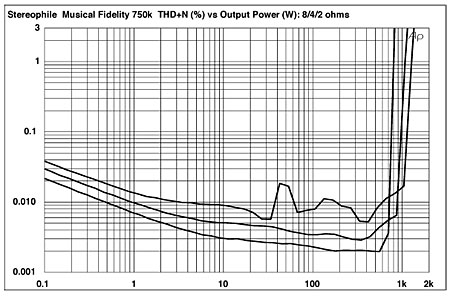
Fig.4 Musical Fidelity 750K Supercharger, distortion (%) vs 1kHz continuous output power into (from bottom to top at 100W): 8, 4, 2 ohms.
Plotting the THD+N percentage against frequency at a moderately high power level (fig.5) again shows that the Supercharger is more comfortable driving 8 and 4 ohms than it is 2 ohms. The THD starts to increase above 8kHz or so, due to the amplifier starting to run out of open-loop bandwidth and thus having less gain margin available for the negative feedback to work its magic. Nevertheless, the 750K is still a very low-distortion design. And at moderate powers, the distortion—what there is of it—is subjectively benign low-order harmonics, primarily the third (fig.6). The distortion spectrum looks similar at very high powers into both 8 ohms (fig.7, blue trace) and 4 ohms (red trace), though you can see a power-supply component present at 120Hz, which suggests that the amplifier is breaking a bit of a sweat at these levels. Sidebands at ±120Hz can also be seen flanking the 19 and 20kHz fundamentals as the amplifier drove these HF tones around 3dB below waveform clipping into 4 ohms (fig.8). Actual intermodulation products in this graph are all low, at –90dB or below.
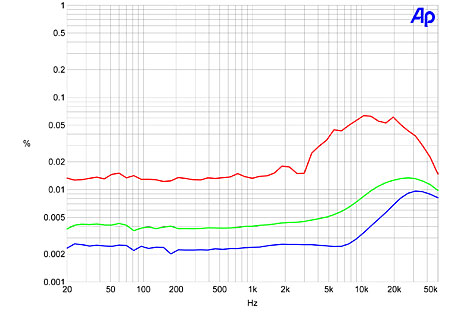
Fig.5 Musical Fidelity 750K Supercharger, THD+N (%) vs frequency at 15.6V into 8 ohms (blue), 4 ohms (green), 2 ohms (red).
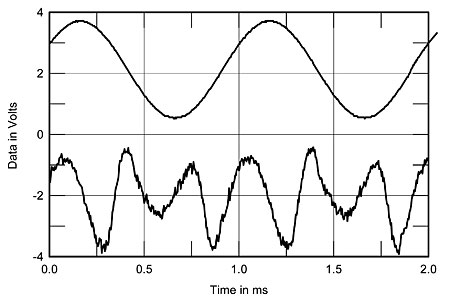
Fig.6 Musical Fidelity 750K Supercharger, 1kHz waveform at 30.6W into 8 ohms (top), 0.00255% THD+N; distortion and noise waveform with fundamental notched out (bottom, not to scale).
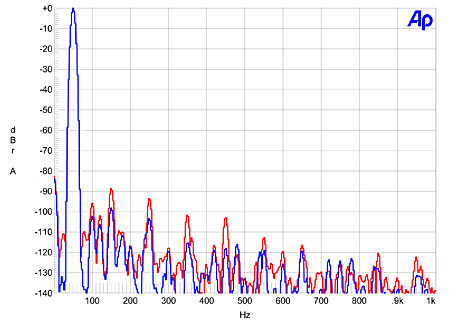
Fig.7 Musical Fidelity 750K Supercharger, spectrum of 50Hz sinewave, DC–1kHz, at 490W into 8 ohms (blue), 950W into 4 ohms (red). (Linear frequency scale.)
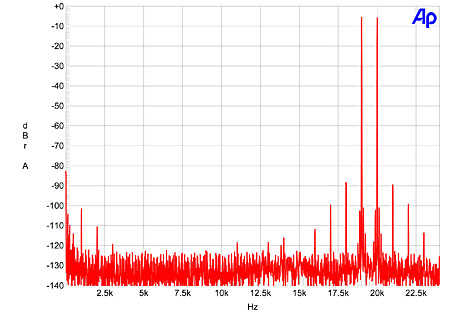
Fig.8 Musical Fidelity 750K Supercharger, HF intermodulation spectrum, DC–24kHz, 19+20kHz at 600W peak into 8 ohms (linear frequency scale).
Overall, Musical Fidelity's 750K Supercharger offers excellent measured performance, but there is no clue as to why I preferred its sound to that of the similarly well-measuring 550K.—John Atkinson

....for Jamicon Electrolytic Polarized input capacitors! For $10K! Really?